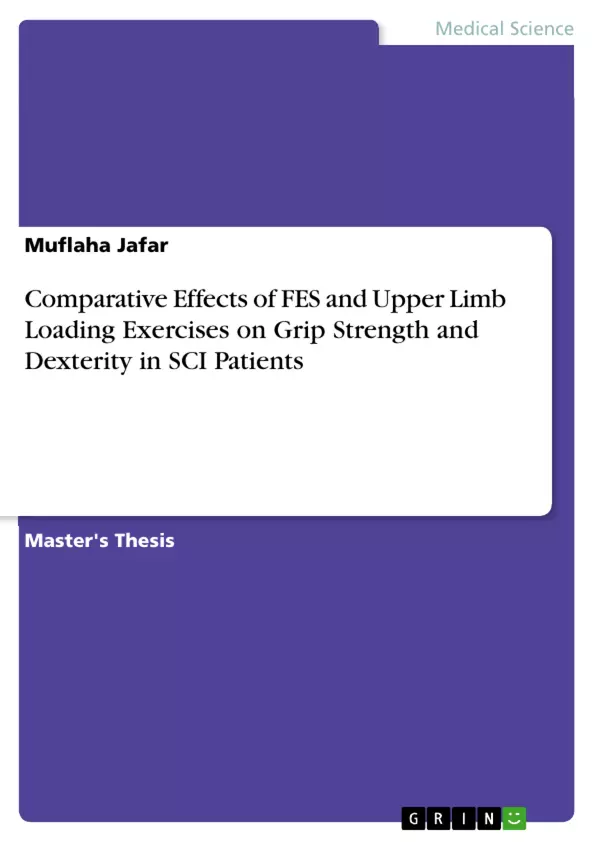Spinal Cord Injury (SCI) rehabilitation aims to activate functional neuronal systems post-injury, seeking enhanced restoration of impaired capabilities. Each SCI patient presents a distinctive set of challenges, with tetraplegics facing more profound impairments compared to paraplegics. This study chiefly investigated the impacts of Functional Electrical Stimulation (FES) versus Upper Limb Loading Exercises on grip strength, dexterity, and overall function among SCI patients.
This research, registered under NCT0586398, took the form of a randomized clinical trial, where 28 participants, identified via a non-probability convenience sampling method, were divided into two groups. The selected participants spanned both genders, ages 20-50, and manifested incomplete SCI at ASIA scale levels C5-T1 in the sub-acute phase. Those on long-term steroids or with any hand or finger amputations were excluded. Group A underwent FES treatment, while Group B engaged in upper limb loading exercises. Both groups received treatments spanning 30 to 45 minutes, five times weekly, over an 8-week period. Outcomes were measured pre and post-intervention using tools such as the modified Action Research Arm Test, handheld dynamometry, and the Nine-Hole Peg Test. Data analysis was executed via the SPSS 25 software.
Inhaltsverzeichnis (Table of Contents)
- 1. Introduction
- 1.1 Objective of the study
- 1.2 Hypothesis
- 1.2.1 True Hypothesis:
- 1.2.2 Null Hypothesis
- 2. Literature Review
- 3. Materials and methods
- 3.1 Design
- 3.2 Sample Size
- 3.3 Study Duration
- 3.4 Sampling Technique
- 3.5 Study Setting
- 3.6 Selection Criteria
- 3.6.1 Inclusion Criteria
- 3.6.2 Exclusion Criteria
- 3.7 Tools
- 3.8 Intervention
- 4. RESULTS
- 5. Discussion
- 6. Conclusion
- 7. References
Zielsetzung und Themenschwerpunkte (Objectives and Key Themes)
This study aims to assess and compare the effects of Functional Electrical Stimulation (FES) and Upper Limb Loading Exercises on grip strength, dexterity, and function in individuals with Spinal Cord Injury (SCI).
- The efficacy of FES and Upper Limb Loading Exercises in SCI rehabilitation.
- The impact of these interventions on grip strength, dexterity, and overall hand function.
- The potential benefits of FES compared to Upper Limb Loading Exercises in improving functional outcomes in individuals with SCI.
- The influence of demographic factors on intervention outcomes.
Zusammenfassung der Kapitel (Chapter Summaries)
The study begins with an introduction outlining the background and objectives of the research. It highlights the importance of engaging functional neuronal systems after SCI to improve impaired functioning. Chapter two delves into a literature review examining previous studies related to FES and Upper Limb Loading Exercises in SCI rehabilitation. Chapter three details the methods used in the study, including the design, sample size, study duration, sampling technique, study setting, selection criteria, tools, and intervention protocols. The results of the study are presented in chapter four, analyzing the effects of each intervention group on grip strength, dexterity, and overall function. Chapter five discusses the findings and their implications, exploring the potential mechanisms of action and clinical significance.
Schlüsselwörter (Keywords)
The study primarily focuses on Functional Electrical Stimulation (FES), Upper Limb Loading Exercises, grip strength, dexterity, hand function, Action Research Arm Test (ARAT), Nine-Hole Peg Test (9HPT), and Spinal Cord Injury (SCI).
- Quote paper
- Muflaha Jafar (Author), 2023, Comparative Effects of FES and Upper Limb Loading Exercises on Grip Strength and Dexterity in SCI Patients, Munich, GRIN Verlag, https://www.grin.com/document/1380645



